RTJ - going to extraordinary lengths
David McGregor is a former intern of the Ohio State University programme (see issue 12). As part of the programme he worked on the US President's golf green at the White House and was seconded to the Robert Trent Jones Golf Club in Virginia, USA.
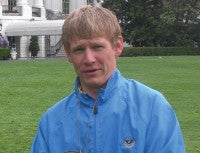 His commitment and dedication was rewarded when, in 2006, RTJ offered him a permanent position at the club. Here he looks back at 2008 and gives a further insight into the work of the OSU programme
His commitment and dedication was rewarded when, in 2006, RTJ offered him a permanent position at the club. Here he looks back at 2008 and gives a further insight into the work of the OSU programme
We have been pushing the boundaries with the quality of the course, continuing to keep it up to date with the modern style required by today's players and the ever advancing equipment technology.
It is easy to quickly lose touch with the highest level of golf course design if we don't keep up to date on the course. So, small, regular projects annually will keep us in the area of the industry we aim to be in.
Since opening in 1991 many changes have been made. The main design is still very much the same but a constant tweaking has kept this course at the highest level of golf. In recent years a new driving range and training facility have been built with plans to construct a new short game area with a par 3 course.
Last year we took a look at our resources and decided that we could make a few changes out on the golf course with a view to lengthening it. This involved tightening fairways, with careful attention to the view of the fairway from each tee box, and building five new tees.
Starting right at the beginning of 2008 we began by reshaping selected fairways. Whilst this sounds straightforward, it is not as simple as just recutting new fairway lines once the grass starts to grow at the beginning of the season.
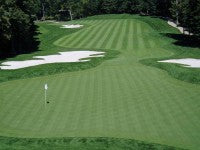
|
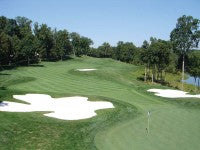
|
From the fairway to rough we have three different turf species; fairway-Pencross Bentgrass, first cut rough (one mower width) ryegrass and rough, tall fescue. This meant that we had to move a lot of turf around. First we removed the bentgrass in the areas we were tightening. Whilst cutting the turf we had to be careful not to damage the first cut of rough as we were also going to be transplanting this.
At this stage we had the bentgrass edge cut so the shapes of the fairways were what we wanted. We then cut up the ryegrass along the old fairway edge so we were able to literally slide the turf across to the new fairway line. This is a long process. When curves and large bends are taken out of fairways a lot more good turf is left over, so this was used to replace contaminated areas around the course. This left us with open bare areas in the rough which we turfed out once we had finished moving all the fairway and first cut surfaces.
In mid August the second phase of the course lengthening began; the contruction of five new tee positions designed to extend the yardage of each hole.
We started on number 3 where we built two new tees. We also had to extend the irrigation lines from the existing tees, adding six new sprinkler heads in total. We chose this hole to start with, firstly due to the accessibility from the road for bringing in materials and, also, the land topography which was in our favour due to an elevation change that we wanted to include. This reduced the amount of build-up soil needed, so the construction would be a lot quicker.
We set our temporary benchmarks and mapped out our subgrade. We used a Bobcat to level the subgrade which also compacted the soil to how we wanted it.
Once we had checked the grade with the laser level we brought in sand from our turf nursery, from beneath the turf, which significantly reduced costs on new material. This was a spiral sand and the grass species harvested was L-93 creeping bentgrass.
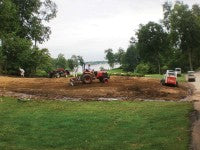
|
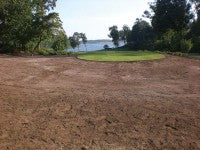
|
The tee was built with four inches of sand across the subgrade and with a 2% slope from front to back to allow for drainage. Once we had a layer of sand covering the bottom we set out new benchmarks and set out stakes for the surface height. We had the whacker plate running constantly to achieve a good solid sand surface and to eliminate settlement. We watered the sand every few hours to keep it moist and easier to work with. Once we had reached our four inches we fine tuned the tee surface, checking heights with the laser. Every square foot of the tee was checked at least twice ensuring the surface was 100% to grade.
The tee surrounds were pretty easy to tie in due to the existing ground levels and, once this was completed, the whole area was spread with fertiliser and soil amendments and lightly raked in.
 We then turfed the tee surface to the shape we desired, with constant watering to reduce stress. The surrounding area would be turfed with transplanted turf from where we would be building our next tee (hole 11).
We then turfed the tee surface to the shape we desired, with constant watering to reduce stress. The surrounding area would be turfed with transplanted turf from where we would be building our next tee (hole 11).
This next tee build wasn't going to be as easy as the last one. We had to raise the ground level ten feet, so we bought in over 100 tonnes of subgrade soil just to get to the required height! We were very precise about the shaping and appearance of the new tees; we wanted them to look like they had always been there. So, when raising ten feet, we had some major tie in work to ensure we achieved this.
We completed three tees in three weeks. We rolled and topdressed weekly bringing the tees into play four weeks later ready for our member tournaments late in the season. We are in the process of constructing another new tee on hole 7 as I write this.
Once the course lengthening is completed we will have added 130 yards, including a 600 yard par 5, a 500 yard par 4 and a 215 yard par 3 (over water the whole way).
Bunker reconstruction
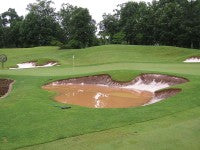 Due to the changing weather patterns here in Virginia a 100% efficient drainage system is very important for many reasons. Our members demand tournament conditions on a daily basis so, the day after a storm or heavy rain, means a very busy and long day for the greenkeeping staff.
Due to the changing weather patterns here in Virginia a 100% efficient drainage system is very important for many reasons. Our members demand tournament conditions on a daily basis so, the day after a storm or heavy rain, means a very busy and long day for the greenkeeping staff.
Our bunkers are the biggest problem due to the fact that they have very little drainage and wash out very easily. A typical morning fixing bunkers will take a crew of up to thirty, pumping out standing water, scraping out silt to prevent contamination, fixing washouts, raking the middles with a sandpro then, finally, hand raking.
This is a tall order when we have seventy bunkers covering six acres. Our aim is to stay in front of the first tee time at 7.30am and, if we don't achieve this, we have failed to provide what our members expect.
Over the past few years we have been installing new drainage in some of our bunkers, mainly aimed at better playability and less maintenance. The system is called Air-core. We have found this system prevents washouts, even on steep faces, and we have never seen any standing water or silt collection, even after excessive rainfall.
The Air-core bunkers are now so easy to get back into play. We simply sandpro the middle and hand rake the rest. The concept is very simple. It allows the water to run along the base of the bunker without taking any sand with it.
To install the system we begin by cleaning out the bunker and removing any existing sand. To achieve the best results we shape the bunker rather like a kitchen sink, with a drain at the lowest point connected to a pipe that lets the water escape.
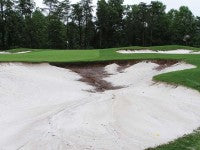 The bunker is then lined, as if it were a pond, and a hole is cut where the drain is. We then line the bunker with drainage felt, a half inch thick mesh covered with felt. It comes in 25ft wide rolls so, in most cases, we can cut a piece that will fit the base of the bunker perfectly. This product allows the sand to sit on the felt with the mesh below.
The bunker is then lined, as if it were a pond, and a hole is cut where the drain is. We then line the bunker with drainage felt, a half inch thick mesh covered with felt. It comes in 25ft wide rolls so, in most cases, we can cut a piece that will fit the base of the bunker perfectly. This product allows the sand to sit on the felt with the mesh below.
The mesh allows the flow of water below the sand keeping all sand in place. Not only does this cut out sand movement, it keeps it in perfect condition. Once we have the felt and mesh in place we then replace all the sand, whacking it every six inches. We then shape the bunker with the sand. We do have different sand depths, due to the slightly bowled base not reflecting the surface shape of the sand, but this is never a problem as the sand compacts down firm.
Our aim is for the faces to have a soft, one inch, cover of sand, so a ball would never stay up and would always roll down to the middle where we have two to three inches of soft sand. These are not our total sand depths, it is the top surface to allow for good playability. This is what we call the fluffy sand. Once we are one inch away from our desired sand level we would cut the liner around the edge just below the grass level and peg it into the side then, finally, finish the sand level off and whack and rake for the last time.
We completed two bunkers in 2008 and aim to have all the bunkers completed over the next few years.
Tournament Setup
One of the main terms we use to describe our management practices is "attention to detail". We pay great attention to the tournaments we hold throughout the year for our members. Having a big televised event, as we often do, is great but the members tournaments are equally, if not more, important. It takes some extra special work to achieve tournament conditions especially in regard to green speeds and bunker firmness.
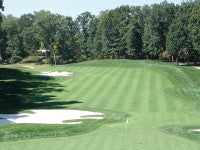 The tournament preparation starts about three weeks prior to the event. This is when we start looking at green speeds, slowly increasing the speed by proper management practices and not just rolling them to death. We start by double cutting and rolling each day and, once we are within a foot of what we aim for, we will just keep them there. If needed we will cut in the evening at the beginning of the tournament week, just to push them a little more. During this time we are working from sun up to sun down, edging, pruning and generally taking out all imperfections.
The tournament preparation starts about three weeks prior to the event. This is when we start looking at green speeds, slowly increasing the speed by proper management practices and not just rolling them to death. We start by double cutting and rolling each day and, once we are within a foot of what we aim for, we will just keep them there. If needed we will cut in the evening at the beginning of the tournament week, just to push them a little more. During this time we are working from sun up to sun down, edging, pruning and generally taking out all imperfections.
Once in the week of the tournament we fill all divots from the past week and top up old ones, ensuring they are filled correctly so that ball movement is not affected if it rolls over a filled divot.
For the morning of the tournament we cut every surface - greens, tees, approaches, fairways, first cut and rough - rake all the bunkers and then set-up the course. The crew work around the course hole by hole and are followed by the greens rollers and two assistant superintendents. They change holes, move tee markers and check for any imperfections like grass clippings, leaves, sand on bunker edges, misplaced rakes and ensure that rope lines are perfectly straight.
A lot of thought goes into the tee marker placement. This means that we take into consideration the wind and the ball roll. We start by looking at the par 3s and ensure that all distances are all different e.g. 160 yards, 185 yards, 210 yards. We want the player to use a different club on each of these holes.
For the par 5s we make a few short and a few long, changing the playability and the approach each day. It is the same with the par 4s, trying to make the player think when they are standing on the tee, making sure they are using a variety of shots and clubs.
Doing these small adjustments to the set up makes playing the course a bigger challenge and a lot more enjoyable.
Internship
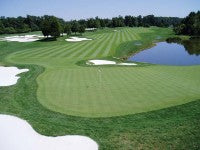 The internship programme we operate here plays a big part in the running of the golf course. We have interns from all around the world, aiming at around six each year.
The internship programme we operate here plays a big part in the running of the golf course. We have interns from all around the world, aiming at around six each year.
The process starts in the autumn when we evaluate the interns from the summer and try and build on the experience they had with us. This year, we tried something different and developed a page on the club's website detailing all the past intern info and future plans for any students applying. This is aimed at getting our information out to as many people as possible.
In the past we have sent out CDs but we felt we weren't getting the info into the correct channels, or to the students, easyily enough for them. Having been an intern myself on the Ohio State programme I feel that the mid Atlantic region is a great place to learn vast amounts about cool season turf grass. You really see the limits you can put the turf through and still achieve great results.
Last season our intern programme was full. We had six students with us, three from the USA and three 'internationals', some from April till December and some just June through to August. This brings a new atmosphere to the working environment with all the different nationalities we have here.
Our crew is split up into three sections so there are two interns on each crew. This enables them to experience all aspects of our operation. We put great trust in these guys and make sure they gain valuable experience throughout their time here. At the end of their term with us they will have worked on all machinery and carried out all the different maintenance practices.
We particularly focus them on the detailed and precise work that is needed like spraying, fertiliser applications, wilt watching on greens, changing cups, irrigation and management of small projects. You could, in many ways, call them second assistants.
A few added extras on the programme include going to the AT&T National Tiger Woods Invitational and working the tournament week, visiting the White House and carrying out renovation to the President's putting green and lawns - in 2007 the crew actually met George W Bush outside the Oval office. We all spoke to him in a relaxed, but somewhat surreal, situation.
The internship is an amazing experience and I believe I wouldn't be in the position I am now without making a small, but very significant, step over from England.
I would like to thank my wife Kimberly for all of her support, everyone at Ohio State University, especially Mike O'Keeffe, and the Robert Trent Jones Golf Club for helping me progress my career in the USA. And, of course, Nigel White from Moulten College in the UK, who got me started on my greenkeeping adventure.
David may be contacted by emailing: davejmcgregor@hotmail.co.uk
